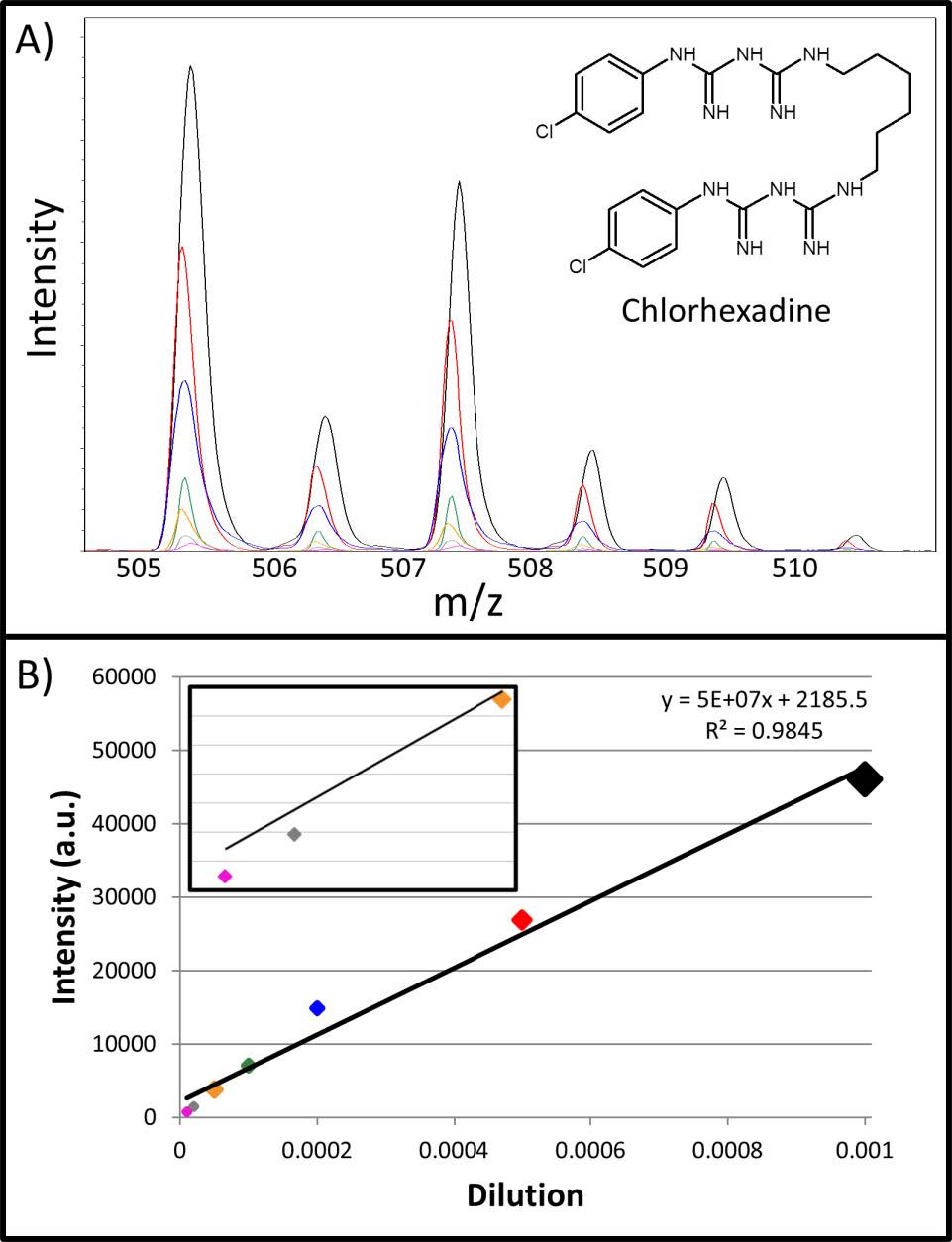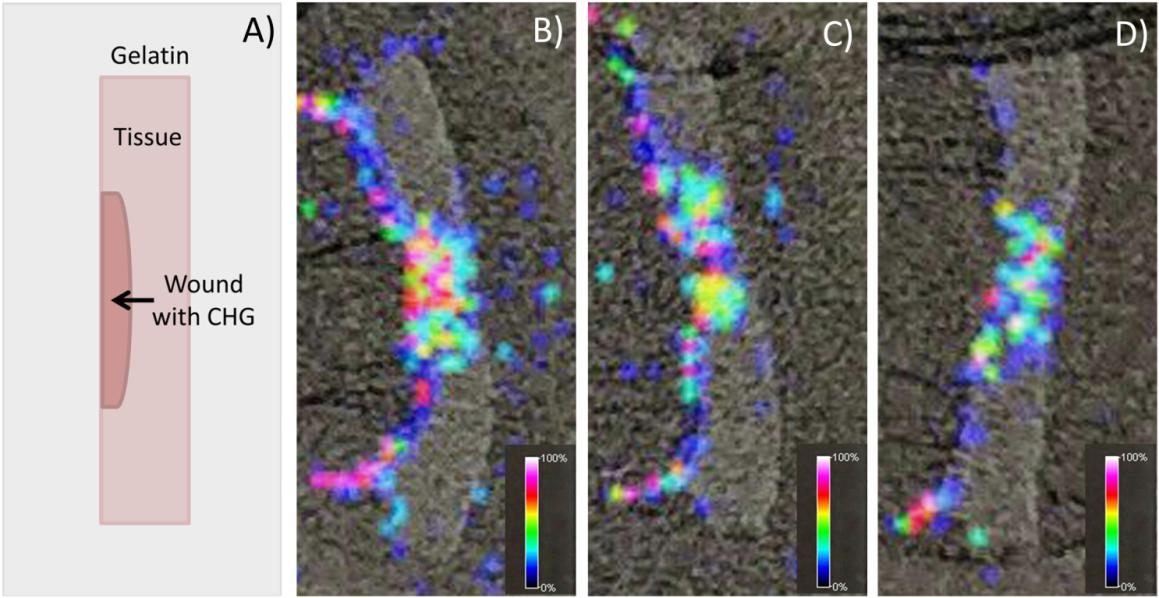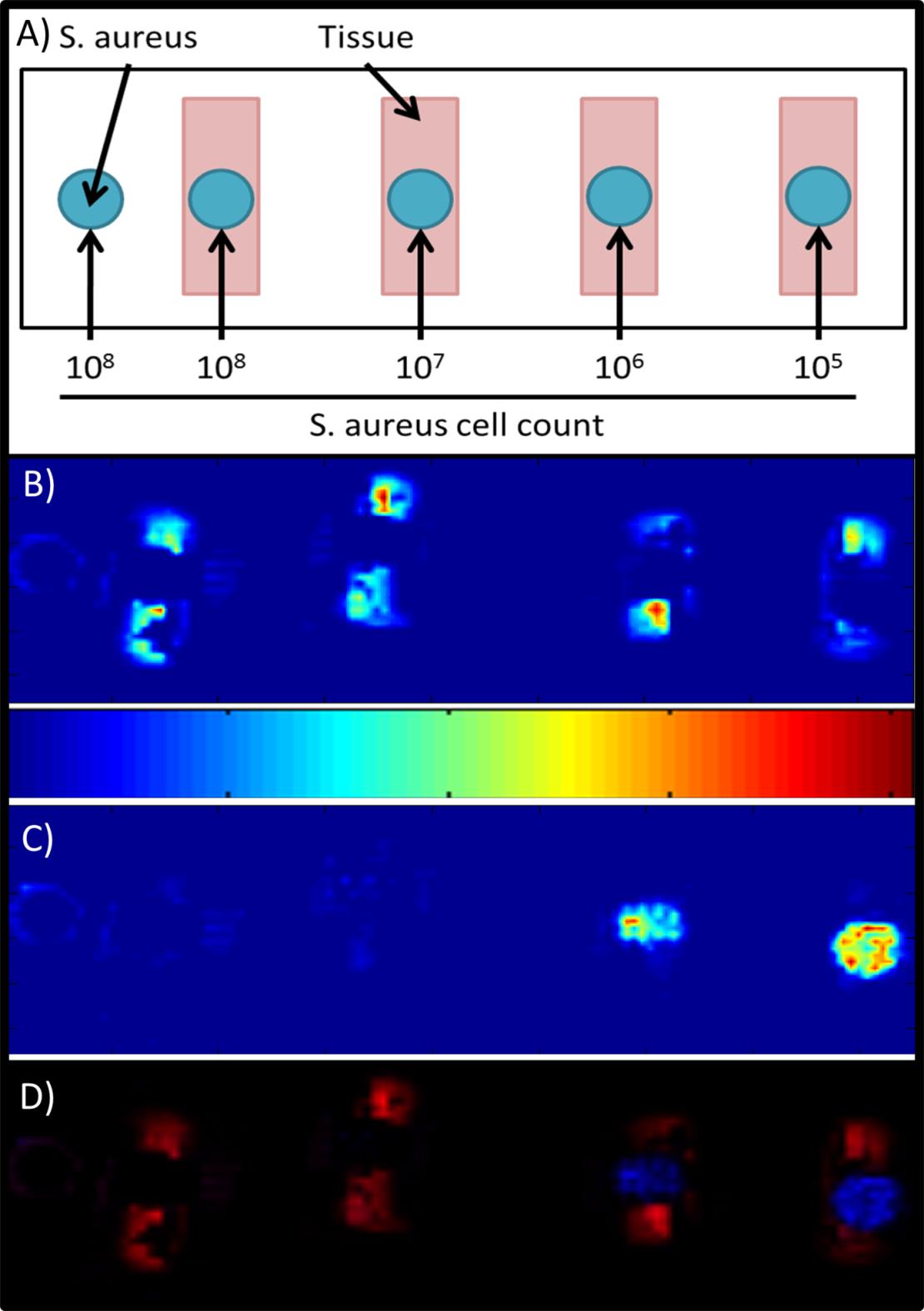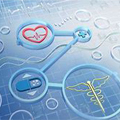1. Introduction
Acute and chronic wounds are a major healthcare concern. Millions of Americans are affected each year and it is estimated that associated costs are greater than 25 billion dollars annually [1,2,3]. A wound is defined as the disruption of normal anatomic structure and function of a tissue or organ [2,4]. Wounds can be classified into two categories, acute and chronic. Acute wounds progress through a sequential process of healing, resulting in the restoration of anatomic and functional integrity [4]. Chronic wounds are those which fail to heal in an orderly and timely fashion, leaving anatomical and functional integrity unrestored [4]. Chronic wounds often result in hospital stays, costing patients both time and money [1,2,3,4]. Additionally, there is an increased risk for patients with chronic wounds to develop infections, lengthening the time to heal and further increasing cost of treatment [3,4]. Bacterial infections can be present in both types of wounds and can further complicate the healing process, particularly if biofilms develop. Often, chronic wounds are a direct result of biofilm infections, where normal healing processes become disrupted due to the presence of bacteria in the biofilm [2]. Antimicrobial agents for the treatment of infected wounds have been developed by major healthcare corporations and include ionic/elemental silver, povidone-iodine, and chlorhexidine gluconate (CHG) [2].
CHG came from synthetic efforts in the mid 1950’s to find new compounds which exhibited antimicrobial activity [5]. Along with other bisdiguanides, it has strong antibacterial activity and is used for wound dressings, oral care, and pre/post-operative showering or bathing [5,6,7,8,9,10,11]. CHG is a cationic bisbiguanide with broad antimicrobial activity, low mammalian toxicity, and a strong affinity for binding to skin and mucous membranes [12,13,14]. At low concentrations, CHG is bacteriostatic and at higher concentrations is an effective bactericide, active against both gram-positive and gram-negative bacteria [12,14,15]. Due to its positive charge at physiological pH, CHG binds tightly to negatively charged membranes and cell walls of bacteria, where it disrupts integrity of the barrier, leading to the release of potassium ions, phosphorus ions, and pentose sugars, as well as inhibiting ATPase activity [13,14,15]. At higher concentrations, CHG causes the cytoplasm contents to precipitate, leading to cell death [13,14,15]. The effectiveness of CHG has made it a leading antimicrobial agent for coating wound dressings as a deterrent to infection [16,17].
Despite nearly 60 years of general use as a wound care agent and an extensive body of literature supporting the use of CHG on wound dressings, studies to investigate localization and persistence within wounds are limited. In part, this is due to the difficulty associated with collecting analytical data with high spatial resolution. The advent of mass spectrometry-based imaging now makes it possible to collect data on the presence of molecules across a wide-range of molecular weights [18,19,20]. One of the leading technologies in this area is matrix assisted laser desorption ionization imaging mass spectrometry (MALDI-IMS). In this technique, a matrix is applied to sectioned tissue. When exposed to a focused UV laser, analytes (e.g. CHG) become ionized and subsequently mass is measured using a time of flight (TOF) mass spectrometer [19]. By rastering the laser across the tissue and measuring the abundance of ions at each spot (pixel), a two-dimensional image based on ion intensity can be generated. A schematic of the general MALDI-IMS method as used in this study is shown in Figure 1. By stacking images, a full spatial representation of a wound in three-dimensions can be created. To investigate the interaction of CHG and wounded skin, in vitro tissue samples with artificial wounds produced by a biopsy punch were treated with CHG to mimic exposure from a dressing, and analyzed using MALDI-IMS. In addition to investigating the localization and penetration of CHG on in vitro tissue samples, tissue contaminated with Staphylococcus aureus was also analyzed. This study demonstrates that MALDI-IMS can be used to track the distribution of bacteria and antimicrobial agents on wounded tissue.
2. Materials and Method
2.1. Reagents
All solvents for MALDI analysis were of HPLC grade; water from Avantor (Center Valley, PA) and methanol from EMD Chemicals Inc. (Gibbstown, NJ). Gelatin for cyrosectioning was purchased from Hardy Diagnostics (Cat. No. C7921, Santa Maria, CA). The matrix 2,5-dihydroxybenzoic acid (DHB) was purchased from Alfa Aesar (Cat. No. A11459, Ward Hill, MA) and formic acid (98% GR ACS) for use as an ion pairing agent was purchased from EMD Chemicals Inc. (Gibbstown, NJ). CHG digluconate (CHG) 20% w/v in H2O for serial dilutions was purchased from Sigma-Aldrich (CAS No. 018472-51-0, St. Louis, MO). Indium tin oxide (ITO) coated glass slides for MALDI-IMS were purchased from Bruker Daltoniks GmbH (Cat. No. 237001, Bremen, Germany). Trypic soy broth (TSB, Soybean-Casein Digest Medium) for growth of Staphylococcus aureus 10943 was purchased from BD Diagnostics (Cat. No. 211825, Franklin Lakes, New Jersey). EpiDermFT (EFT-300) tissue samples were obtained from MatTek Corporation (Ashland, MA) with a 3 mm wound generated by biopsy punch. Physiological saline (0.9%) was obtained from Hospira, Inc. (Lake Forest, Illinois).
2.2. Sectioning of tissue samples
Tissue samples were sectioned as previously described by Ye et al. [22]. Briefly, tissues were embedded in 100 mg/mL gelatin, and flash frozen in an ethanol/dry ice bath. Frozen tissues were stored at −80 °C until sectioning. For sectioning,5 μm slices were produced with a cryostat at −20 °C, and thaw mounted directly onto ITO glass slides. Following sectioning, tissue slices were dehydrated in a desiccator before being coated with DHB matrix (150 mg/mL in 50% aqueous methanol with 0.05% formic acid) using an airbrush. Airbrush application was done using a paint airbrush sprayer, held approximately 25 cm from the slide, moving in a zig-zag pattern for approximately 30 seconds, followed by 1 minute drying time. This was repeated until 15 mL of matrix solution had been dispensed (approximately 10 passes). Matrix coated samples were placed in a desiccator to dehydrate until analysis by MALDI-IMS.
2.3. Growth of S. aureus and placement on sectioned tissue
Staphylococcus aureus strain 10943 was used in this study and is a methicillin-resistant clinical wound isolate obtained from the Southwest Regional Wound Care Center (Lubbock, TX) that has been previously used for biofilm evaluation of antimicrobial wound dressings [23,24]. To prepare the bacteria, a tube of tryptic soy broth (10 mL) was inoculated from a frozen stock culture and incubated at 37 °C overnight to achieve an approximate cell density of 108 CFU/mL. Ten-fold serial dilutions were then prepared in phosphate-buffered saline to achieve the desired bacterial concentrations. Actual bacterial concentrations were determined by plate count on tryptic soy agar. Bacteria at four concentrations (108, 107, 106, and 105 CFU/mL) were placed on top of sectioned tissue using a pipet before being coated with DHB matrix for MALDI-IMS analysis.
2.4. MALDI-MS data acquisition for calibration curve of CHG standard and analysis
Data was collected using a Bruker autoflex III MALDI-TOF/TOF mass spectrometer (Bruker Daltonics, Billerica, MA) equipped with a Smartbeam Nd:YAG 355 nm laser. The instrument was operated in positive ion mode using the TOF reflectron. Bruker flexControl v3.3 software was used to control the instrument and data analysis was done using flexAnalysis v3.3 (Bruker Daltonics, Billerica, MA). A 20% CHG (w/v) in water stock solution was diluted in HPLC grade water; 1:1000 (0.02% w/v), 1:2000 (0.01% w/v), 1:5000 (0.004% w/v), 1:10,000 (0.002% w/v), 1:20,000 (0.001% w/v), 1:50,000 (0.0004% w/v), and 1:100,000 (0.0002% w/v) for the standard curve. Spots were placed onto a Bruker MTP 384 Polished Steel TF target plate (Part No. 8209520) for analysis.
2.5. MALDI-IMS data acquisition and analysis for CHG and staph on tissue samples
Image data was collected using an automated method with the following settings. Spectra from tissue samples were generated by averaging 500 laser shots for each pixel. The sample was rastered at a resolution of 200 × 200 μm. Data files were analyzed using fleximaging v2.1 software (Bruker Daltonics, Billerica, MA) or exported as an IMG file (.img) and imported into MSiReader v0.05 (North Carolina State University). For each experiment data was normalized by total ion count using the flexImaging software, relative to the noise level, in order to facilitate direct comparisons across each image generated.
3. Results
3.1. Generation of CHG standard curve
To assess the potential for using MALDI-IMS as a quantitative tool for the analysis of CHG, the first step was to demonstrate that CHG could be detected at relevant levels and that a reproducible standard curve could be generated. A dilution series of CHG was spotted onto the analysis plate and analyzed using 2,5-dihydroxybenzoic acid (DHB) matrix. The mass spectrum obtained from each dilution showed intense ions at 505.2 and 507.2 m/z which match the expected CHG isotope pattern due to the presence of chlorine, 35Cl and37Cl respectively (Figure 2A). A change in signal intensity for the isotope distribution was observed for the different samples. Using this data, a standard curve was generated from a dilutions series in which CHG stock solution (20% w/v in H2O) was diluted in water to final concentrations of 0.02% w/v to 0.0002% w/v. The standard curve was based on intensity of the monoisotopic peak of CHG (molecular weight of 504.2 [M+H equals 505.2] and chemical formula of C22H30Cl2N10). The coefficient of determination was 0.98 across two orders of magnitude for the dilution series (Figure 2B).
3.2. Detection and localization of CHG on tissue assessed by MALDI-IMS
Having ascertained that CHG could be measured at clinically relevant concentrations, we next moved to the analysis of sectioned tissue samples treated with CHG. In vitro tissue samples which had a wound induced via biopsy punch were gently washed with a solution of 0.05% (w/v) CHG. Following this, tissue samples were flash frozen in a gelatin matrix and subsequently sectioned in 5 μm slices onto indium-tin-oxide (ITO) coated glass slides. Slides were then sprayed with DHB before MALDI-IMS analysis (Figure1). Each tissue section is surrounded by a gelatin matrix to aid sectioning. The induced wound was located on the left side after sectioning (Figure 3B-D) and was the surface of the tissue to which CHG was applied prior to sectioning. Each pixel in the image was generated by summing 500 laser shots. The three images are sequential sections from the same tissue sample analyzed in one imaging sequence. Data was acquired in 200 × 200 μm steps, moving from left to right, top to bottom. The ion intensity of CHG was extracted from each pixel and converted into an ion density map for each tissue section (Figure 3B-D). CHG abundance was localized to the wound site.
3.3. Imaging of Staphylococcus aureus in wounds
Having shown that MALDI-IMS can be used in a targeted approach to detect CHG on tissue, the next step was to see if bacteria could be detected on tissue. S. aureus is a gram positive bacterium found on the skin. It is a common cause of skin and wound infections. To investigate the potential for using MALDI-IMS for the detection of S. aureus, the same experimental method used for CHG imaging was repeated. Sectioned tissue was spotted with S. aureus at four different concentrations. Additionally, bacterial cells were spotted directly onto the glass slide as a positive control. The slide was sprayed with DHB matrix and analyzed using MALDI-IMS. Figure 4A shows a diagram of the layout of tissue and cells placed on an ITO coated MALDI slide. Decreasing numbers of S. aureus were spotted in the center of each tissue section.
Unlike the CHG experiment, the molecular signature for S. aureus was not known. Therefore the entire data range (100 to 1000 m/z) needed to be analyzed for ions that could be used for creating an image. Ions uniquely associated with the bacteria and the tissue were mined using MSiReader software. MSiReader allows a user to select an area of interest and compare it to a reference area, pulling out features unique to the area of interest above a signal-to-noise (S/N) threshold of 10. A series of eight ions unique to S. aureus were found by analyzing an area containing only bacterial cells (Table 1). A second set of 10 ions unique to tissue were also identified. Features from these lists were used to map bacterial cells and tissue. Using the ions 229.4 and 260.5 m/z, images were generated to map S. aureus and tissue respectively (Figure 4B and C). These two ions were selected to generate images due to the fact that their average intensity is in the middle of those measured in Table 1,thus giving a good representation of overall image quality. Overlaying the two data sets produced a complete image of the tissue surface which revealed the precise location of S. aureus (Figure 4D). In the overlay heat map image blue represents S. aureus and red represents tissue. As can be seen in panels 4C and 4D, the ions specific for S. aureus are only seen when lower cell concentrations are spotted onto the slide (106 and 105 cells respectively). Suppression of ionization can occur under certain sample conditions, particularly when analytes are at high concentrations, such as was the case when high cell concentrations were used [25,26]. Using MALDI-IMS, molecular features can be used to distinguish tissue from cells in a spatially resolved environment.
Table 1. Ions unique to specific samples.
| S. aureus m/z | Intensity | Tissue m/z | Intensity |
| 142.7 | 28 | 103.9 | 250 |
| 192.6 | 46 | 109.2 | 21 |
| 198.6 | 434 | 109.8 | 22 |
| 213.5 | 54 | 114.9 | 79 |
| 229.4 | 26 | 153.8 | 41 |
| 360.1 | 33 | 183.7 | 238 |
| 376 | 21 | 238.6 | 46 |
| 391.9 | 22 | 260.5 | 72 |
| | 272.4 | 145 |
| | 282.4 | 59 |
4. Discussion
The ability to detect CHG across a wide range of concentrations demonstrates that MALDI-MS analysis of the antimicrobial agent has the potential to quantify the amount in a sample of interest. The characteristic pattern of isotope peaks due to the chlorine isotopes (35Cl and 37Cl) makes CHG easy to identify in the spectrum, as there are few molecules which would be present in a biological sample that contain chlorine ions. With the knowledge that CHG can be detected and quantified, analysis of in vitro tissue samples after injury was attempted (Figure3). Results from these experiments show that CHG ion intensity was concentrated in the region where the biopsy punch was made. No CHG was found to be present on control samples which did not receive biopsy punch prior to CHG treated as expected (data not shown). The highest observed intensity was in the tissue section taken from the center of the wound (Figure3B), moving outward from the center of the wound (Figure3C and D) signal intensity decreased, suggesting that CHG is retained better by damaged tissue. A relatively low concentration of CHG was observed on the left side of the tissue section. This surface was the top of the tissue before sectioning and the residual is likely due to weakly bound CHG remaining on the surface after washing and is to be expected as CHG is known to bind the surface of tissues [12,13,14]. No penetration into the tissue can be seen outside the area of the wound. This is consistent with the idea that CHG does not penetrate the outer most layer of epidermis, except where there is a lesion or break in the skin. Additionally, it does not appear that CHG diffuses away from the site of the wound. The ability to image CHG in a semi-quantitative manner shows the potential for MALDI-IMS as a tool for studying the distribution, penetration, and persistence of CHG directly from tissue and wounds.
Following the analysis of CHG on tissue samples, MALDI-IMS was applied to tissue samples which were sectioned and spotted with S. aureus. The goal of this analysis was to determine if chemically unique features for tissue and bacterial cells could be used to generate an image. Our results show that this is feasible. The images shown in Figure 4 clearly delineate the location of S. aureus. The images were produced based on the distribution of two ions (260.5 and 229.4). MALDI-IMS data is very rich, suggesting that complex images displaying numerous chemical distributions can be generated. Interestingly, the unique molecular features for the bacterial cells were only present with the lower concentration of cells. When greater numbers of S. aureus were present, an overall ion suppression in those pixels was observed. A likely explanation is that at very high cell concentration suppression of the MALDI process is occurring [25,26]. This may be an artifact of the experimental method used here, however, further testing would need to be conducted. These results demonstrate that bacteria can be imaged on tissue using MALDI-IMS and suggest that this method could be used to investigate growth on tissue and wound models.
Using standard MALDI-IMS methodology, images with sub-millimeter resolution can be produced. Unique chemical signals can be used to localize bacteria and antimicrobial agents. The distribution of the antimicrobial compound CHG was determined for tissue sections from an in vitro wound model system. The results show that CHG remains localized to the area around the wound and that penetration into the tissue at the wound site was minimal. The common skin bacteria and clinically relevant infectious agent S. aureus produced eight unique ions. Together, these results suggest that MALDI-IMS can be a powerful tool for studying bacterial colonization of wounds and how the distribution of compounds such as CHG in and around wounds impacts bacteria. The relatively high spatial resolution and specific mass signals of MALDI-IMS offers distinct advantages over other techniques. Future studies will be needed to assess if the technique works for other bacterial strains and other antimicrobial agents. Also, more detailed level of detection and level of quantification studies will be needed to establish how broadly applicable the method will be.
Acknowledgments
Tim Hamerly would like to recognize support from the Kopriva Graduate Fellowship at MSU. The mass spectrometry facility at MSU receives funding from the Murdock Charitable Trust and NIH 5P20RR02437 of the CoBRE program. We would like to acknowledge Jesse Thomas for technical assistance with MALDI-TOF instrumentation. The authors would like to thank Erin Gemperline for her advice on cyrosectioning, matrix application techniques, data acquisition and analysis.
Conflict of Interest
The authors claim no conflict of interest.









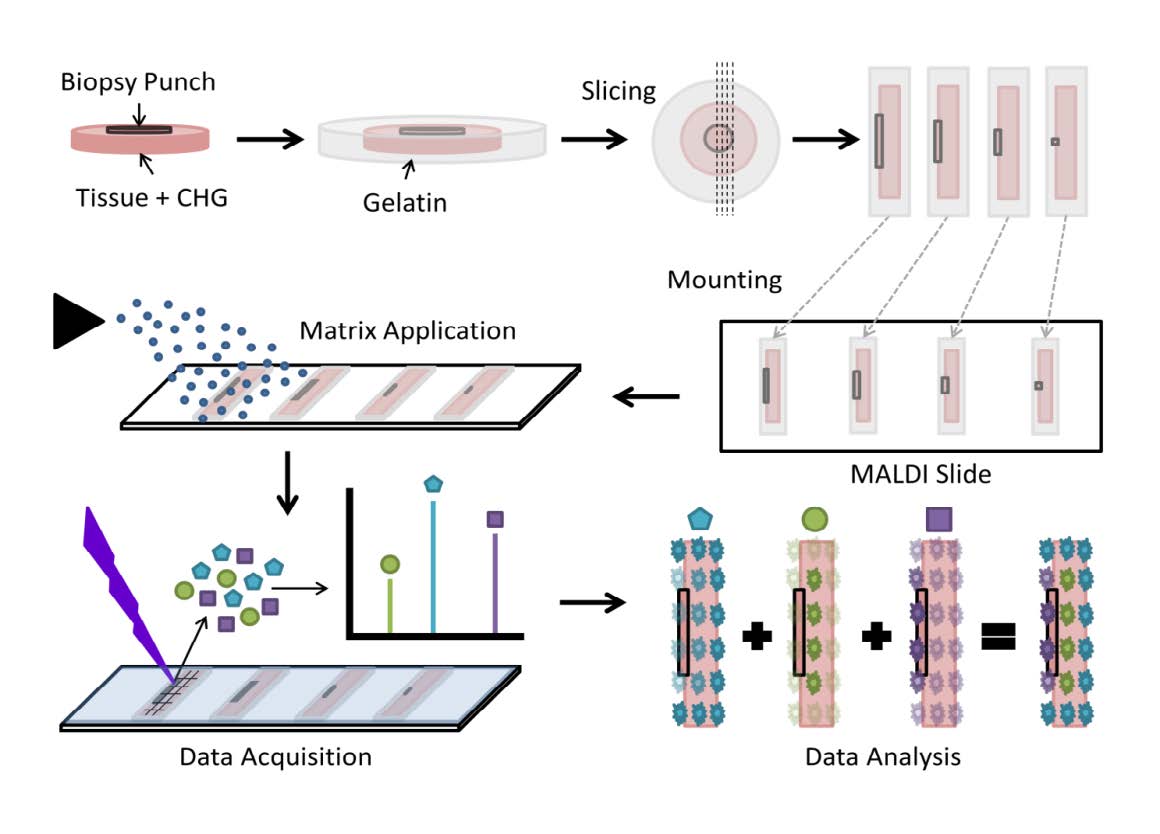
 DownLoad:
DownLoad: 